Ayodhya Ram Mandir: “Pilgrimage (Dham) for 1 billion Hindus”
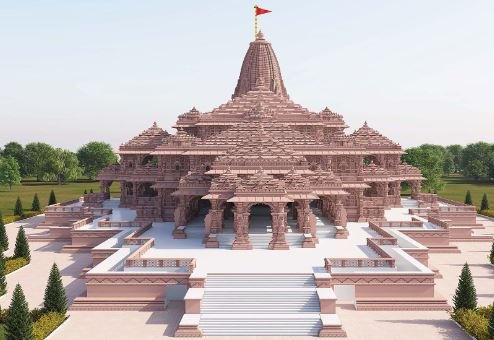

ॐ श्री रामाय नमः॥
Om Shri Ramaya Namah॥
“Muslims also know that there was a temple but they will not accept it openly, because they don’t want to solve the issue”
K.K. Muhammed
On January 22nd, 2024, more than 1 billion Hindus around the world will be lighting Diwas in their houses and celebrating Diwali. One can wonder if the Festival of Lights “Diwali” is celebrated during October / November month (also called Karthik month as per the Hindu calendar), then how Diwali is celebrated in January. The reason is simple on January 22nd, 2024, Pran Parthisha (establishment of life force in idol) of Lord Ram will be done on his birthplace Ayodhya.
The Ram Mandir, also known as Lord Shri Ram Ayodhya Temple, is a Hindu temple located in the birthplace of Lord Shri Ram at Ayodhya, Uttar Pradesh, India. The new Hindu temple at Ram Janmabhoomi is being built, and Hindus worldwide are excited about its opening
Not to mention, the temple has been the center of the longest-standing religious and political dispute in India.
It reminds me of the comment made by Aabhas K Maldahiyar:
“The people’s struggle over Sri Ram Janmabhoomi and reinstating the Sri Ram Mandir on the site has a long history.
After the partition of Bharat in 1947, the ruling congress party made Ayodhya’s Ram Janmabhoomi a contentious issue in Indian politics for decades until it was finally settled by the Indian Supreme Court in 2019, and ruled in favor of the construction of a Ram Janmabhoomi temple on the birthplace of Lord Shri Ram.
Finally, the construction of the Ram temple was undertaken by the “Shri Ram Janmabhoomi Teerth Kshetra”, a trust formed by the Indian government to oversee the construction of the temple.
Let’s now have a retrospective of what happened in the past 600 years / 6 long centuries.
While visiting Ayodhya in 1608 AD, English businessman William Finch, associated with the East India Company, observed hundreds of thousands of devotees visiting the ruins in Ramkot, Ayodhya, which is the birthplace of Lord Ram. At this sacred location, women engaged in worship amid the ruins and performed circumambulation, a spectacle that both fascinated and piqued the curiosity of the English merchant.

For Hindus, this place held great religious significance, and the devotees referred to it as Ram Janmabhoomi.
In his diary, Finch documented his observations, noting, “At Ramkot in Ayodhya, there are also the ruins of the palace and houses of Ranichand whom the Indians acknowledged as a great god, saying that he had assumed the body to behold the spectacle of the world. Certain Brahmins are living in these ruins, who record the names of all the Indians who bathe in the river that flows there.” This historical account provides a glimpse into the cultural and religious landscape of Ayodhya during that period[1].
It is clear from Finch’s statement that when he went to Ayodhya, there were ruins among all the temples in Ramkot. While he didn’t mention the Babri Masjid, it’s crucial to delve into the nature of the ruins that existed among the temples in Ramkot during his visit. The absence of a detailed description of these ruins prompts questions about why people held such strong beliefs in them. Finch provides some insight into the significance of these ruins, indicating the profound faith devotees had in them.
William Finch’s statement makes it very evident that upon his visit to Ayodhya, he observed ruins among the temples in Ramkot. Although he did not specifically mention the Babri Masjid, it is important to consider which ruins he referred to and why people were worshipping at those sites.
By now you must have got a glimpse of what’s Ram-Janmabhoomi truth is but let’s go through the chronology of how the dispute started and finally came to an end.
Shri Kush(kusha), Lord Ram’s son built this temple in Ayodhya. At that time, there were more than 3000 temples was there.
For the next 190 years, the Mughal Empire was way too powerful.

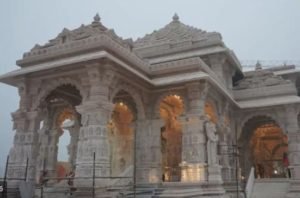
William Finch’s historical account indeed sheds light on the presence of ruins among the palaces in Ayodhya during his visit, and the intriguing aspect is the central focus of people’s faith in these ruins. This observation gains significance when considered in the context of the later demolition of the Babri Masjid. The events following the demolition, including the discovery of stone slabs indicating the construction by Mir Baqi, align with the long-standing claim that the Babri Masjid was built after the destruction of the Ram Janmabhoomi temple.
Finch’s narrative suggests that, under the instructions of Babar in 1528, Mir Baqi, the commander, had demolished the existing temple and erected the Babri Masjid. While Finch’s account is brief and doesn’t provide all the details, it contributes to addressing questions and understanding the historical context surrounding Ayodhya and the complex issues related to the Babri Masjid and the Ram Janmabhoomi temple.
While there remains, a dispute regarding whether the Ram Janmabhoomi was demolished under Babar’s instructions or during the rule of Aurangzeb, the stone inscription found in the Babri Masjid indicates that Baqi was responsible for constructing the mosque.
The existence of Baqi’s grave in Sahanwa village near Ayodhya adds to the historical evidence, establishing that Baqi, also known as Baki Tashkenti from Uzbekistan, was entrusted by Babar with the responsibility of Awadh[1].
The historical accounts and writings of various foreign tourists and historians have indeed highlighted the transformation of three significant Hindu holy places in Ayodhya, Kashi, and Mathura into mosques.
Surgeon General Edward Balfour, in his book “Encyclopedia of India” and of Eastern and Southern Asia published in 1858, noted the presence of mosques at these religious sites, including one on the Ram Janmabhoomi in Ayodhya. Balfour, having visited India had conducted extensive research on these matters.
Nevertheless, the accounts from Muslim writers, such as those found in Naseer Bahadur Shahi’s book “Sahifa-e-Chahal” and an article from the “Hadiqa-e-Shahada” book published in Lucknow in 1856, highlight the perspective of demolishing temples against idolatry and the intent to establish mosques in their place.
In the 17th century, the granddaughter of Aurangzeb expressed the decision of Muslim kings to prevent idol worship and eliminate concessions to Hindus, emphasizing the determination to discourage idolatry at any cost.
Police officer and writer Kishore Kunal states that all the claimed inscriptions about the date on the Babri Mosque were fake & very recent. They were affixed sometime around 1813 (almost 285 years) after the supposed construction of the mosque in 1528. Till the 1940s, the Disputed Structure was called “Masjid-i-Janmasthan” including in official documents such as revenue records.
Archaeologist K.K. Muhammed, renowned archaeologist and writer of the book ‘Main Hoon Bhartiya’ (I am Indian) has narrated
“I Have Seen Proof of a Temple”
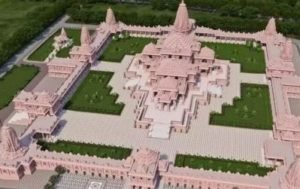
It’s an open secret that the Ram Mandir issue has been used as a rallying point by different political parties in India. It has influenced electoral campaigns, coalition formations, and public sentiment. The dispute has been a significant factor in shaping political discourse in the country. However, Various cases related to the ownership and title dispute of the site have been filed in different courts over the years. These legal battles have played a very crucial role in the resolution of the dispute and have been a source of contention among the involved parties.
When we talk about dirty politics then how we can forget the distortion done by Marxist followers in India? They appeared on behalf of the Babri Masjid Action Committee as experts, though none of their testimony speaks of it. Right from the beginning their argument was ideology-driven and few even went on to contradict their statements. The attacks and commentaries by them in publications, which went on to create the popular anti-Ram Janmabhoomi Mandir narrative were not based on facts or historicity, but on creating an emotional appeal for Babri Masjid.
Four Babri Action Committee historians namely R. S. Sharma, D.N. Jha, Suraj Bhan & Athar Ali insisted that they be treated as independent historians, but many organizations like Vishwa Hindu Parishad refused to agree to this demand. There were evidence exchanges but it helped little in shaking the determination of the proponents of Babri masjid.
Although the gang had power & the establishment supported it, however, the coterie kept behaving like a broken record… oops…?.
The main arguments they put forward which indeed are bogus like Lord Shri Ram is a mythic figure and that identification of present-day Ayodhya with Valmiki’s Ayodhya is highly incorrect as variants of Rama story are proof that Valmiki version is not accurate. They provided evidence of Buddhist texts stating Kosala and not Ayodhya as Ram Janmabhoomi. Marxist Propagator’s shamelessness has no limits when they stated that Ayodhya is a sacred place of Buddhists and Jains and not Hindus and Ayodhya has not been a place of pilgrimage for Hindus for a very long time.
Marxist stoops stated that there was no Rama cult before the thirteenth century and the Babri masjid was built on virgin land. They also tried to influence that the architectural remnants are brought from elsewhere and planted there. They also try to prove that the remnants discovered from beneath the structure are nonreligious [3].
The Lord Shri Ram Mandir issue has provided a hot platform for media both internationally and at home. It has generated discussions on religious tolerance, secularism, and communal harmony in India. It was a hot topic of interest among scholars, journalists, and international organizations concerned with human rights and religious freedom which were doing so to raise their TRPs.
It is no doubt that Lord Shri Ram Temple’s struggle also had a profound impact on the social and cultural fabric of India. It has highlighted the deep-rooted religious sentiments, the struggle for identity, and the complexities of pluralism and secularism in Indian society. This is the reason that over the years, various attempts were made to resolve the dispute through mediation and negotiation. Several individuals, including religious leaders, scholars, and politicians, were involved in the mediation efforts to find a peaceful resolution to the issue. However, these efforts did not lead to a conclusive resolution until the Supreme Court’s verdict.
The 600 old Lord Shri Ram Janmabhoomi case reached the Supreme Court after the parties appealed against a 2010 Allahabad High Court ruling, which had, in the absence of a title, divided the 2.7 acre disputed land in Ayodhya, Uttar Pradesh, equally between the three primary parties.
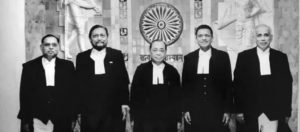
The Supreme Court five-judge bench led by the then Chief Justice of India, Ranjan Gogoi, on November 9, 2019, delivered its historic verdict in the Ayodhya land dispute case. The bench comprised Justices SA Bobde, Ashok Bhushan, DY Chandrachud, and Abdul Nazeer.
The Judgement passed by the Supreme Court in 2019 granted legal sanction for the construction of the Ram Mandir at Ayodhya. The temple is set to be inaugurated on January 22nd, 2024.
It’s not that the Supreme Court didn’t try other peaceful methods to resolve this strenuous issue. Before hearing the land dispute on merits, the five-judge bench decided to refer the case to mediation. In February 2019, the bench appointed retired SC judge Fakkir Mohamed Ibrahim Kalifulla, Sri Sri Ravi Shankar, and senior advocate cum mediation expert Sriram Panchu as mediators.
After deliberating for close to six months, in August 2019 the panel told the court that no settlement had been reached through mediation. The court decided to immediately commence the hearing of the case. However, during the hearing, the mediators submitted a report stating that some of the parties desired to settle the dispute. The Court decided to proceed with the hearing nevertheless after telling the parties to approach the mediators in case there was a settlement. In October 2019, when the hearing was reaching its final stage the mediation panel submitted a report stating that a settlement had been arrived at by some of the parties.
The main contesting parties in the suit were Ram Lalla Virajman (Idol of lord Ram), Nirmohi Akhara (a Vaishvanite denomination), and Uttar Pradesh Sunni Central Waqf Board. All these parties claimed ownership of the land.
The five-judge bench, unanimously ruled that the disputed land would be given to the central government and directed the central government to form a trust within three months to monitor and manage the construction of a temple at the site.
The court further directed the government to give the Sunni Waqf Board an alternative and suitable five-acre plot of land at a prominent place in Ayodhya[4].
Lord Shri Ram Mandir at Ayodhya is a grand temple built in the Nagara style of temple architecture, characterized by its towering spires or shikhara.
The temple is built using pink sandstone and is spread across an area of 2.77 acres. The temple is surrounded by a large courtyard and has several smaller shrines dedicated to other Hindu deities. The most striking feature of the temple is the giant Shaligram stone, a black stone believed to represent Lord Ram and brought from the Gandaki River in Nepal.
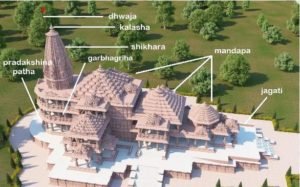
The temple is 161 feet high and has three floors, each with a different purpose. The first floor is dedicated to Lord Ram, while the second floor is dedicated to Lord Hanuman, and the third floor is a museum showcasing the history and culture of Ayodhya.
The temple complex also includes a Yajna Shala or a hall for conducting yajnas or Hindu fire rituals, a community kitchen, and a medical facility. The temple complex is spread over 67 acres and is expected to become a major cultural and religious center, attracting millions of devotees from around the world[5].
Ram temple at Ayodhya is expected to contribute to the development of “Ayodhya Dham” as a major religious and cultural center. It is also expected to create jobs and generate economic growth in the region. The temple is expected to attract millions of devotees from across India and the world, contributing to the development of “Ayodhya Dham” as a major religious and cultural center.
श्री राम जय राम जय जय राम॥
Shri Rama Jaya Rama Jaya Jaya Rama॥
[1] Understanding the history of Ram temple through the eyes of foreign travellers (moneycontrol.com)
[2] Ayodhya Ram Temple: History of Ram Janmabhoomi | LinkedIn
[3] A Brief History of Sri Ram Janmabhoomi Movement- Genesis to the Present (organiser.org)
[4] Ayodhya Ram Mandir: Unique things about the Supreme Court’s judgement in the case (moneycontrol.com)
[5] Ayodhya Ram Mandir: History, Architecture, Significance, and How to Reach the Lord Ram Temple (trimbakeshwar.org)
DISCLAIMER: The author is solely responsible for the views expressed in this article. The author carries the responsibility for citing and/or licensing of images utilized within the text.
